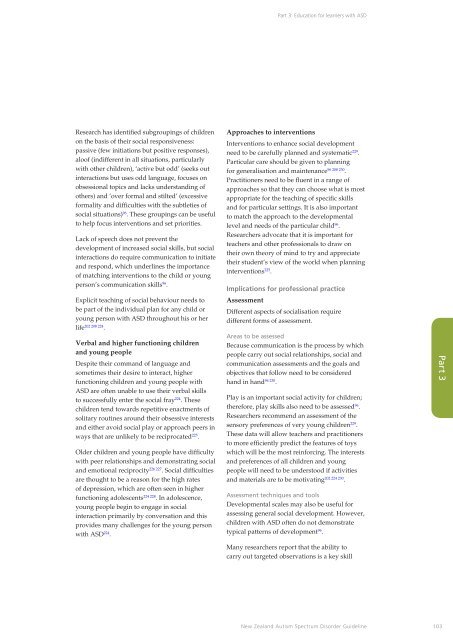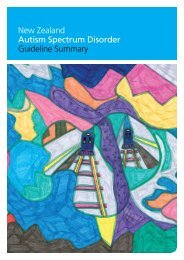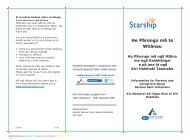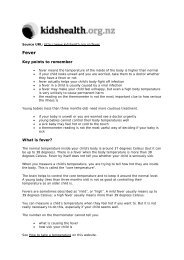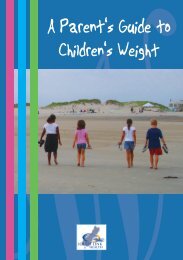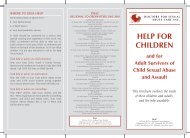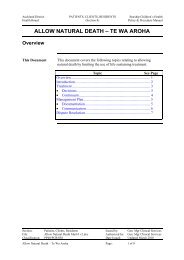New Zealand Autism Spectrum Disorder Guideline - Ministry of Health
New Zealand Autism Spectrum Disorder Guideline - Ministry of Health
New Zealand Autism Spectrum Disorder Guideline - Ministry of Health
Create successful ePaper yourself
Turn your PDF publications into a flip-book with our unique Google optimized e-Paper software.
Part 3: Education for learners with ASD<br />
Research has identified subgroupings <strong>of</strong> children<br />
on the basis <strong>of</strong> their social responsiveness:<br />
passive (few initiations but positive responses),<br />
alo<strong>of</strong> (indifferent in all situations, particularly<br />
with other children), ‘active but odd’ (seeks out<br />
interactions but uses odd language, focuses on<br />
obsessional topics and lacks understanding <strong>of</strong><br />
others) and ‘over formal and stilted’ (excessive<br />
formality and difficulties with the subtleties <strong>of</strong><br />
social situations) 96 . These groupings can be useful<br />
to help focus interventions and set priorities.<br />
Lack <strong>of</strong> speech does not prevent the<br />
development <strong>of</strong> increased social skills, but social<br />
interactions do require communication to initiate<br />
and respond, which underlines the importance<br />
<strong>of</strong> matching interventions to the child or young<br />
person’s communication skills 96 .<br />
Explicit teaching <strong>of</strong> social behaviour needs to<br />
be part <strong>of</strong> the individual plan for any child or<br />
young person with ASD throughout his or her<br />
life 202 208 224 .<br />
Verbal and higher functioning children<br />
and young people<br />
Despite their command <strong>of</strong> language and<br />
sometimes their desire to interact, higher<br />
functioning children and young people with<br />
ASD are <strong>of</strong>ten unable to use their verbal skills<br />
to successfully enter the social fray 224 . These<br />
children tend towards repetitive enactments <strong>of</strong><br />
solitary routines around their obsessive interests<br />
and either avoid social play or approach peers in<br />
ways that are unlikely to be reciprocated 225 .<br />
Older children and young people have difficulty<br />
with peer relationships and demonstrating social<br />
and emotional reciprocity 226 227 . Social difficulties<br />
are thought to be a reason for the high rates<br />
<strong>of</strong> depression, which are <strong>of</strong>ten seen in higher<br />
functioning adolescents 224 228 . In adolescence,<br />
young people begin to engage in social<br />
interaction primarily by conversation and this<br />
provides many challenges for the young person<br />
with ASD 224 .<br />
Approaches to interventions<br />
Interventions to enhance social development<br />
need to be carefully planned and systematic 229 .<br />
Particular care should be given to planning<br />
for generalisation and maintenance 96 208 230 .<br />
Practitioners need to be fluent in a range <strong>of</strong><br />
approaches so that they can choose what is most<br />
appropriate for the teaching <strong>of</strong> specific skills<br />
and for particular settings. It is also important<br />
to match the approach to the developmental<br />
level and needs <strong>of</strong> the particular child 96 .<br />
Researchers advocate that it is important for<br />
teachers and other pr<strong>of</strong>essionals to draw on<br />
their own theory <strong>of</strong> mind to try and appreciate<br />
their student’s view <strong>of</strong> the world when planning<br />
interventions 225 .<br />
Implications for pr<strong>of</strong>essional practice<br />
Assessment<br />
Different aspects <strong>of</strong> socialisation require<br />
different forms <strong>of</strong> assessment.<br />
Areas to be assessed<br />
Because communication is the process by which<br />
people carry out social relationships, social and<br />
communication assessments and the goals and<br />
objectives that follow need to be considered<br />
hand in hand 96 230 .<br />
Play is an important social activity for children;<br />
therefore, play skills also need to be assessed 96 .<br />
Researchers recommend an assessment <strong>of</strong> the<br />
sensory preferences <strong>of</strong> very young children 229 .<br />
These data will allow teachers and practitioners<br />
to more efficiently predict the features <strong>of</strong> toys<br />
which will be the most reinforcing. The interests<br />
and preferences <strong>of</strong> all children and young<br />
people will need to be understood if activities<br />
and materials are to be motivating 202 224 230 .<br />
Assessment techniques and tools<br />
Developmental scales may also be useful for<br />
assessing general social development. However,<br />
children with ASD <strong>of</strong>ten do not demonstrate<br />
typical patterns <strong>of</strong> development 96 .<br />
Part 3<br />
Many researchers report that the ability to<br />
carry out targeted observations is a key skill<br />
<strong>New</strong> <strong>Zealand</strong> <strong>Autism</strong> <strong>Spectrum</strong> <strong>Disorder</strong> <strong>Guideline</strong> 103


